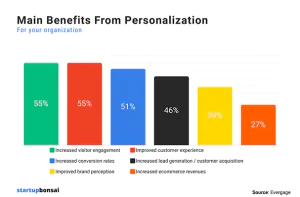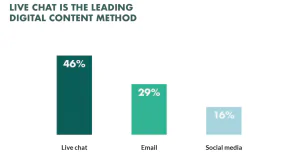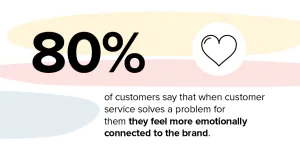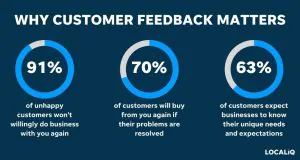Everyone knows your name… But do they like you?
Brand experience means everything to consumers, but businesses often miss the mark. You need research, personalization, and customer-centric marketing campaigns. The best way to achieve this and build brand loyalty is to use your customers’ reviews as your guiding star.
Customer feedback or sentiment measures buyers’ emotions toward your brand. You can determine whether target consumers have positive, negative or neutral feelings about your business and products.
This data is VITAL for successful businesses because you can optimize your brand experience to speak to your audience’s pain points, and build positive sentiment.
Customer-centric businesses are 60% more profitable than other brands, and 66% of buyers expect companies to understand their needs.
So, how do you skyrocket revenue through customer feedback analysis for your brand?
Don’t worry, we’ve got you covered!
This research-backed guide explores customer responses, sentiment examples, methods for measurement, and effective sentiment analysis techniques.
Ready?
Here we go!
It refers to customers’ perception of your brand on an emotional level. Although you may receive loads of social media mentions and buyer interactions, it doesn’t detail how target customers feel when engaging with your brand.
We all know how pivotal it is to understand your customers, and their feedback provides a whole new aspect to stimulate positive customer experiences and build customer loyalty.
The more positive experiences your customers have, the more likely you are to secure repeat customers and added traction.
Statistics show that over 70% of buyers evaluate customer experience before making a purchase decision. In the past year, almost 50% of customers have left businesses because of poor customer experience.
Use your buyer’s sentiment to accurately determine customers’ experience with your brand. You can evaluate which percentage of your audience feels positively toward your business, which feels negatively, and how many feel neutral.
Armed with this knowledge, you can identify which aspects of your business need attention to improve your brand’s perception and which contribute the most to your good reputation.
Summary: What is Customer Sentiment?
It describes customers’ emotions when engaging with your brand. Do customers feel positively, negatively, or neutral toward your brand, and why? Understanding their sentiment is essential to optimizing your marketing strategies and driving brand loyalty.
Source: Hot Topics
There are many reasons why your customer reviews are imperative for businesses to understand. The key reasons are to gain deeper customer insights, deliver an improved brand experience, and secure a stronger competitive advantage.
These benefits allow you to personalize your marketing tactics, engage buyers, and stand out from competitors with custom strategies that reflect your brand values.
The more information you know about your buyers, the better. Eighty percent of buyers are more likely to purchase from companies with personalized brand experiences.
Customer feedback provides an entirely new aspect of what you know about your target audience.
Analytics and buying trends shed light on how your customers make purchases and on their behavior. But their feedback reveals what your audience feels about you.
You can be a well-respected brand with a sterling reputation, but that doesn’t necessarily mean people like you or would stay loyal to your brand if an equivalent option that they liked more was available.
If you notice you’re evoking more negativity than good, you have data to modify and personalize your approach.
How customers feel about your business will change over time. By using their sentiment, you can stay ahead of your customers by understanding information beyond buying trends and market statistics.
You can identify what they feel and why they feel that way so that you can address areas causing damage and strengthen the areas driving positive sentiment.

Having a competitive advantage helps businesses in all sectors. With so many new brands, many sectors demand fresh and relevant approaches.
You can gain a competitive advantage with customer feedback by analyzing your competitors’ buyers. There are many free online tools to do this for you. When you understand how buyers feel about your competitors, you can use their weaknesses to your advantage.
Customers may feel more positive about your competitors, and that’s okay because you have a sentiment analysis to improve your approach.
If you don’t consider your customer’s feedback, you won’t know what your audience feels about you vs. your competitors and how you can reign the market.
Brand experience is key to building brand loyalty. Customers are logically inclined to return to businesses that provide positive experiences.
When customers have negative experiences, and you don’t know this, you can’t prevent this negativity from escalating and becoming critical to your success.
Unfortunately, not every buyer will directly voice their displeasure, so you must take one step ahead and evaluate this.
Robust analysis of customer feedback provides actionable insights to optimize your brand experience. You can determine which aspects of your sales and marketing strategies aren’t working and what internal or external problems you face.
Are customers unhappy with your delivery process? How can you change this? Do buyers feel your products lack quality? How would you solve this?
Without this analysis, you’ll have to use limited information to progress your brand experience. The longer you ignore your customers’ feelings about your business, the worse it can become.

Summary: Why is Customer Sentiment Important?
If you’re a small or medium business with moderate reviews, analyze these reviews by looking through them. Analyzing the language used in these reviews can reveal what customers feel about your brand.
Is most of your feedback negative? What do buyers dislike about your business? Do you have a swarm of positive responses, and what are you doing right? Which aspects of your business are garnering which emotions?
One review can reveal insight into multiple aspects of your business, from product quality to customer service to shipping, and each aspect may carry it’s own sentiment.
Encouraging customer feedback is a fantastic way to get reviews. And more reviews equals more data to evaluate your buyers’ reviews.

If you have many reviews, social media mentions, and other channels for customer feedback, use an analysis tool.
You can use these tools even if you have low online traction but want accurate and detailed customer insights. There are lots of customer analysis tools, and some are free.
Many also don’t require downloading them, and they are available online or through Chrome extensions.
What valuable features do these analysis tools offer?
Intuitive dashboards with all relevant data
Detailed reports for evaluation
Competitor customer feedback analysis
Real-time suggestions for improved customer experience
Analytics and tracking for customer interactions and sentiment
Some of the best customer analysis tools are:
Use a survey builder like SurveyMonkey to create intuitive surveys for direct customer feedback. This method works because you’re “hearing it from the horse’s mouth”.
There’s no better way to determine your customer feedback than to ask your customer base. Not all buyers may be interested in a survey, so promote it in a way that seems beneficial to customers.
Use an angle like, “So we can improve your customer experience, tell us what doesn’t work…”. You can promote your survey through website popups, email newsletters, SMS marketing, live chat, customer service calls, and social media.
Some businesses ask customers to stay on the line after a customer service or sales call and rate their service. This method is a way of gathering important data.
It’s not new for buyers to express how they feel about brands through social media. Some business owners assume that a high number of social media mentions directs to the business doing something right.
However, this isn’t true, and it does take much for poor customer service or unfair business practices to go viral. You should not only use analysis tools to determine how social users feel about your brand but also strike conversations with buyers.
Using social media to converse with buyers allows you to gather more feedback. While surveys and user reviews aren’t guaranteed to pull results, you can open another channel to mine customer feedback data with social media conversations.
This means responding to customer comments (which you should already be doing), DMs, and social mentions.
You can also check the social platforms your buyers mostly use. Consider hashtags and keywords related to your brand to help you determine what social users think about your company.
Have you ever thought about soliciting audience feedback through one-on-one conversations? You can do this through what we call “user interviews”.
User interviews are personal conversations with current or new buyers. These interviews give you direct information about feedback because buyers can’t structure or plan what they say, like in surveys, reviews, and social media comments.

However, user interviews are time-consuming, and finding participants is tricky. You can work with recruiting agencies to find participants, reach out to popular influencers or reviewers, or host a campaign.
If you host a campaign to invite participants to user interviews, you must have an incentive. Your incentive could be a gift card, a freebie, a discount, or something else valuable to motivate buyers to have one-on-one interviews.
Summary: How to Measure Customer Sentiment?
To measure customer sentiment use and analyze:
Your live chats and customer service calls are direct insights into how your customers feel about interacting with your business. Monitor these interactions to evaluate buyer sentiment. You can’t plan when feedback analysis should occur. When it happens in real-time, have processes for a detailed analysis.

The smaller your business is, the fewer methods you have to consider. Enterprises tend to have bloated methods of evaluating feedback through live chat and customer service calls, leading to a decline in optimized customer experience.
Think back to dealing with insurance companies, banks, and other similar service providers and how frustrating the process usually is.
You have a negative experience with these businesses because their complicated infrastructures make tracking real-time consumer sentiment challenging.
An effective way to track buyer sentiment for live chat and customer service calls is by having agents write a few notes on each interaction.
These notes would detail the problem and resolution and determine whether customers were satisfied at the end of each interaction. When you evaluate these notes, you can figure out where the problem is and what is scaring off buyers.

Social monitoring describes analyzing your social media interaction to determine buyer sentiment. Many brands quickly hide or delete negative social media comments because they don’t want to understand why buyers are unhappy. Only fools would take this route. What your buyers have to say about your business and what they feel about it matters, whether it’s good or bad.
For social monitoring for customer sentiment, consider social media interactions like:
You can use customer sentiment analysis tools for social monitoring too!
Monitoring customer interactions with your brand beyond social media platforms is another example of customer feedback.
Not all conversions will occur on social networks. Some buyers may interact with your brand through a blog, live event, forum discussions, and news platforms. You must have processes to monitor buyer sentiment for your brand on all channels, not just on social media.
But brand monitoring is also vital for future business and product goals. Whether you’re planning to host a social media contest, launch a new range of products or revamp your identity, you must track how customers feel about these changes.
Using consumer sentiment analysis tools makes it possible to evaluate specific aspects of your products, apps, or marketing strategies and expose customers’ emotions. You can easily view all the various aspects of your brand’s social sentiment using one tool.
Here are some essential factors to consider for brand monitoring for customer sentiment:
Not all your customers will provide social sentiment directly to your business. Brand monitoring allows you to gather this data from various sources.
Market research is an example of buyer sentiment analysis to evaluate how buyers respond to marketing campaigns.
Whether you’re launching an email, social media, or SMS marketing campaign, social sentiment will tell you if you’re on the right track.
You can monitor online conversations relating to your brand and marketing campaign. From these insights, brands understand if customers are engaged in the marketing campaign and where they need to improve.
External marketing factors out of your control can impact how buyers feel about your brand. For example, when eco-awareness became more popular, more customers preferred to work with eco-friendly businesses.
Launching an environmental marketing campaign would be the next step and your business can analyze how the market responds to your campaign.
These are a few factors to analyze for customer sentiment market research:
Your brand may have an app, providing an additional channel for customer feedback. Check your star ratings and comments for your app to determine what your audience has to say about your brand.
Also, evaluate your in-app feedback and aspects customers want you to improve. Know what % of your users provide feedback and why others wouldn’t think this is worthwhile.
Compare negative customer reviews against trends of when users become inactive to see if there’s a connection and how you can fix these aspects.

Summary: 5 Best Customer Sentiment Examples
To scale your business with your customers’ reviews, consistently track and evaluate your performance. Successful sentiment analysis isn’t a once-off gig.
Brands must keep their finger on the pulse of buyer feedback for crisis management, fantastic PR, and competitive advantages.
Your audience and their feelings about your business and products will change over time. Don’t lose track of this. Analyze your customer feedback every second week or monthly.
Businesses must also track and evaluate buyer sentiment after product and campaign launches. If you’ve put something out there impacting your buyers, you must know how this changes how they feel about your business.
Customer feedback provides raw data for consumer sentiment analysis. As you generate more reviews and testimonials, you have more data to work with and improve your customer experience.
There are many ways to encourage buyer feedback for customer sentiment analysis like:
When customers leave feedback, respond to them. Nothing makes buyers feel more discarded than businesses that don’t make an effort to respond to reviews and feedback.

Understanding how customers feel about your brand gives you more data to modify your sales funnel and customer service delivery. You’ll know your target buyers’ purchasing challenges queries, and complaints.
To optimize your sales funnel and customer service delivery, consider factors like:
Your sales funnel and customer service are two essential touchpoints for your buyers. Optimizing these approaches makes it easy for buyers to purchase from your brand and for others to effortlessly contact support.
Gather as much data about their feedback for your sales funnel and customer service to enhance your approach.
Buyers aren’t going to rate your service or product if it’s hard for them to do so. You may not get the feedback you’re hoping for, but it’s essential anyway.
If your feedback is negative you can use analysis to improve your products and brand experience. And if your feedback is good, you can build on strategies that buyers are engaging with positively.
But again, to generate customer feedback for analysis, customers must be able to leave reviews easily. You can do this through in-app or website popups, email newsletters, and adding your business to review platforms like Google, Clutch, and G2. Depending on your niche, there may be many or few review platforms.
Responding to these reviews and solving complaints can also earn your brand-added PR points.
If you gain feedback at the end of sales or customer service calls or through surveys, make the process seamless. Customers shouldn’t have to do much to leave a review.
It can be as simple as sending them an SMS after calls or using a dedicated landing page requiring a single click from an email newsletter. Your customers will appreciate how easy you’ve made it for them, and you’ll have more data.
Customer-centric marketing campaigns are the secret to brands that last. The more targeted and personalized your marketing strategies are, the more chance you have of converting.
Customers are likelier to engage in marketing campaigns and tactics that speak to their pain points and offer them competitive solutions.
With customer feedback, you have more valuable data to build marketing campaigns that encompass your brand identity and are targeted at your ideal buyer.
As your customer analysis develops, you’ll have more constructive data to shape your marketing approaches. Businesses can stay ahead of what customers want and don’t want and how they respond to market trends and brand changes. Your marketing campaigns will become much more successful and built for your target audience.
Customer feedback is vital for brands to understand how buyers feel about what they offer. In-depth research can also yield more valuable data!
Sentiment analysis evaluates your consumers’ emotions toward your brand and competitors, how buyers respond to marketing campaigns, and how your audience has changed over time.
The top examples of buyer sentiment are social monitoring, brand monitoring, in-app feedback, market research, and live chat and customer services. To assess and monitor social sentiment, utilize customized surveys and monitor user-generated content. By understanding the sentiment of your customer, you can establish a customer-focused brand quickly.
Customer sentiment describes the emotions buyers feel when interacting with your brand. Brands must analyze and monitor customer sentiment consistently to ensure they leave a positive impression on targeted customers. This article explores the top benefits of customer sentiment, customer sentiment examples to learn from and the best ways customer sentiment can scale your brand.
Customer sentiment is important because you can gain a stronger competitive advantage, deliver an improved brand experience and understand deeper customer insights to personalize your marketing approaches. Read this full article for why brands need customer sentiment, what customer sentiment is, the top examples in 2025 and how to use customer sentiment for growth hacking.
To measure customer sentiment businesses must use social monitoring, evaluate online reviews, use customer sentiment analysis tools, monitor customer service calls and use surveys. You can do many of these processes without using customer sentiment software but software does make it much easier and actionable. Our article covers what customer sentiment is, why businesses need to understand it and how brands must leverage customer sentiment to stand out in a competitive market.
Salesforce: What Are Customer Expectations, and How Have They Changed?
Brain & Company: Are you experienced?
BrightLocal: Local Consumer Review Survey 2024
SmartKarrot: 75 Must-Know Customer Experience Statistics to Move Your Business Forward
Emplifi: Report: 11 key things consumers expect from their brand experiences today
SlideShare: The power of me: The impact of personalization on marketing performance